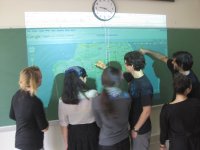A Painter at the Chalkboard: “Old School Tools” in the Classroom
A few weeks ago I was listening to one of my favorite classical radio stations and heard the DJ mention that a famous pianist likes to say he is a "painter at the piano." I thought it was a great metaphor to describe the way many artists and professionals feel about the tools of their work. For example, a carpenter could be a painter with a hammer, a potter could be a painter with a wheel . . . I could go on and on.
It made me think about our profession, education, and the tools we use in the classroom to passionately share our content with our students. I say "passionately" because, in my humble opinion, there can be no other way to use those tools, if not with passion.
New Uses for "Old School Tools"
How important are technology tools in the classroom? And what if I don't have access to them to use with my students? How can I possibly keep up with the rest of my colleagues around the country that do? I get asked those questions a lot when I’m consulting or in webinars. There really isn't an easy answer. What I like to say, however, is that it's not about the tool, it's about how you support your pedagogy with the tools you have, based on principles of good practice.
This got me thinking about the days when I was a teacher and didn't have access to the shiny new tech or web 2.0 tools that are available now. Heck, they weren't even around yet! So what does this mean? Was I a less able teacher because I didn't have those tools? Were my students less successful? Did I hinder their future academic success because I didn't have an interactive whiteboard or iPad? No! I used the tools at my disposal in vibrant and (here's that word again) passionate ways. I'd like to say that I was a painter at the chalkboard.
That said, whether you're a new teacher or an experienced teacher that doesn't have access to all the tech bells and whistles, let's look at three ways that you can still teach great content using some "old school tools."
1) Use Paper to Teach Blogging
Many teachers have their students blogging worldwide. Why? Because it's such a powerful way for them to access their passion for writing and improve their skills in the process. But many other teachers are concerned about the confidentiality of blog platforms and web posting, or don't have access to the technology. Fear not! Take a minute to read this great blog post by my friend Karen McMillan, a seventh grade teacher in Northern California: Learning to Blog Using Paper. You will be so inspired by this process using old school tools, specifically paper and a sticky note, that I know you will want to share it with your students.
2) Use Folders as Apps
As a teacher, I always had access to folders at my school or could find them inexpensively at the stationery store. I had folders for everything and every content area you could think of. Not to mention that I relied heavily on them as a way to store and curate my students' work. Fast forward many years, and folders are still a choice old school tool that teachers are using in surprisingly fresh ways. You only have to type the word "folder" in Pinterest to access literally hundreds of ways that educators are taking this low-tech tool to new levels. From reading to math content, from social studies to science, folders are in active use wherever there are students. Angela Watson is an educational consultant and amazing former teacher who has a site full of tremendous resources. Take a visit to see how she is sharing great ways for teachers to use folders in classroom with students. Her What Are Fun Folders? post includes ways of teaching with this tool that I had not even dreamed of!
3) Use the Chalkboard as Social Media
I know what you're thinking -- the chalkboard? But hold on. Surprisingly to those of us immersed in all things tech, some schools just don't have the financial resources to equip all classrooms with an interactive whiteboard. I know this for a fact, as I've personally worked in many schools in So Cal that have yet to be able to transition away from the chalkboard. So how can we use it effectively? Remember how I shared earlier that I believed myself to be a painter at the chalkboard? This website, How to Use the Chalkboard as an Effective Teaching Tool, offers some great ideas that I think are deserving of your time. You’ll be surprised at how a fresh perspective can help to bring an old school tool to life. (I especially like #5!)
It's the User, Not the Tool
Now that we’ve looked at new ways to use familiar tools, check out this recent Edutopia video that shows how a rural Missouri school is supporting its teachers through professional development opportunities with tools that support learning:
I hope you'll indulge me when I repeat that it's not about the tool -- it's about how you use the tools you have that makes the difference in the learning you share with your students. If we learn to use our tools, no matter what they are, in vibrant ways to support our practice, we will have a major impact on the success of the students in our care.
